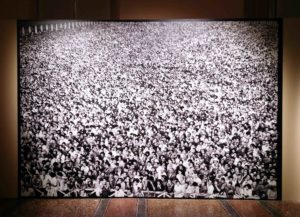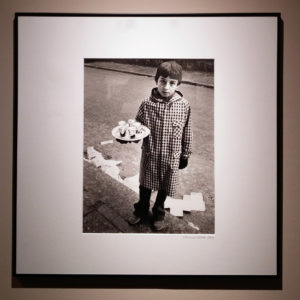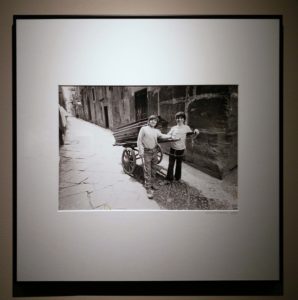 Today well-known for his architectural, archaeological and landscape photography, Mimmo Jodice made first paintings and drawings, but was as well interested in arts in general, classical music and jazz. In the 1960s, he discovered his passion for photography and experimented with materials and forms to question the possibilities of photographical languages and techniques. Collaborating with artists of various avant-garde movements like Pop art, Arte Povera or Fluxus, he portrayed numerous artists, inter alia Andy Warhol, Joseph Beuys and Robert Rauschenberg and got recognised internationally.
Today well-known for his architectural, archaeological and landscape photography, Mimmo Jodice made first paintings and drawings, but was as well interested in arts in general, classical music and jazz. In the 1960s, he discovered his passion for photography and experimented with materials and forms to question the possibilities of photographical languages and techniques. Collaborating with artists of various avant-garde movements like Pop art, Arte Povera or Fluxus, he portrayed numerous artists, inter alia Andy Warhol, Joseph Beuys and Robert Rauschenberg and got recognised internationally.
In the late 1960s and beginning 1970s he was attracted by the social movements spreading all over the world. With Italy on focus, he offered his professional view to the leftist militant press. Besides the documentation of demonstrations, he glanced on working conditions. Perhaps also compassionate because of his own early gainful activity – caused by the early death of his father – Jodice bears testimony of child labour in Naples in the photos of this time. After the years of political and social engagement, suddenly human beings left his images at the end of the 1970s, in favour of the familiar silence urban landscapes.
 Nevertheless, in “The militant Years”, shot between 1967 and 1977, people are still the main protagonists. There are images from manifestations, as the Festival dell’Unità in Naples in 1976, where the crowd of the biggest political and cultural event in the city after the war, is only framed by barriers in the front and far away colonnades in the background. The function of these diagonal lines is only to anchor the mass on the sides to underline the infinity at the upper edge of the picture.
Nevertheless, in “The militant Years”, shot between 1967 and 1977, people are still the main protagonists. There are images from manifestations, as the Festival dell’Unità in Naples in 1976, where the crowd of the biggest political and cultural event in the city after the war, is only framed by barriers in the front and far away colonnades in the background. The function of these diagonal lines is only to anchor the mass on the sides to underline the infinity at the upper edge of the picture.
Other photos of protesters are close-ups from people in action, holding placards or raising the fist. They get their dynamic by the frozen gesture, which permits to imagine the previous as well as the following movement. Similar is the functioning of the station pictures, only underlined by diagonals of rails or trains. This might be workers who are searching their fortune in immigration, due to the heavy luggage and the depicted leaving trains. A manifestation picture hanging besides, where a protester hold up a suitcase with the word “Svizzera” (Switzerland) on it, underlines this impression. Another image shows a little boy holding the leg of a man. Is this a farewell scene? Is the child one of those who are shown at work in the next room?
 Even though most of these child labourers are looking to the camera, their expression is often serious. Besides few exceptions, laughing children are missing. In fact, the pictures exemplify the misery of these kids, who are frequently barefoot, in poor clothes and bleak environments. The black and white execution with shadows and contrast underlines the desolate situation. Frequently the work is manual labour or service, like the little girls in a flower factory, the cigarette seller in the rain or the bar boy, but there are as well photos of industrial labour. Young steelworkers are shown in action, displayed in movement, which is underlined by dynamic lines and spreading sparks. Barely recognisable because of protective clothes and masks, they are only by their physical size to be identified as far too young for this work. Quite macabre is that the by far friendliest image is the one of two boys with a coffin on their handcart. They are well-dressed with light coloured pullovers, have sturdy shoes and are laughing directly into the camera.
Even though most of these child labourers are looking to the camera, their expression is often serious. Besides few exceptions, laughing children are missing. In fact, the pictures exemplify the misery of these kids, who are frequently barefoot, in poor clothes and bleak environments. The black and white execution with shadows and contrast underlines the desolate situation. Frequently the work is manual labour or service, like the little girls in a flower factory, the cigarette seller in the rain or the bar boy, but there are as well photos of industrial labour. Young steelworkers are shown in action, displayed in movement, which is underlined by dynamic lines and spreading sparks. Barely recognisable because of protective clothes and masks, they are only by their physical size to be identified as far too young for this work. Quite macabre is that the by far friendliest image is the one of two boys with a coffin on their handcart. They are well-dressed with light coloured pullovers, have sturdy shoes and are laughing directly into the camera.
We do not know what became of them as adults. Did they made it out of the misery like Mimmo Jodice? Are they still living in precarious situations? What we know is, that child labour is still exists and probably it would as well in Europe without social movements. Through the amelioration of social conditions, the environment is an increasing subject of discussion, particularly because environmental degradation becomes more and more visible. Since years, Josef Koudelka visits industrial landscapes. His photos are showing vividly the effect of human intervention in different countries.
Read more:
Foto/Industria: views on labour and industrial development
Alexander Rodchenko – The industrial World
Mimmo Jodice – The militant Years

















